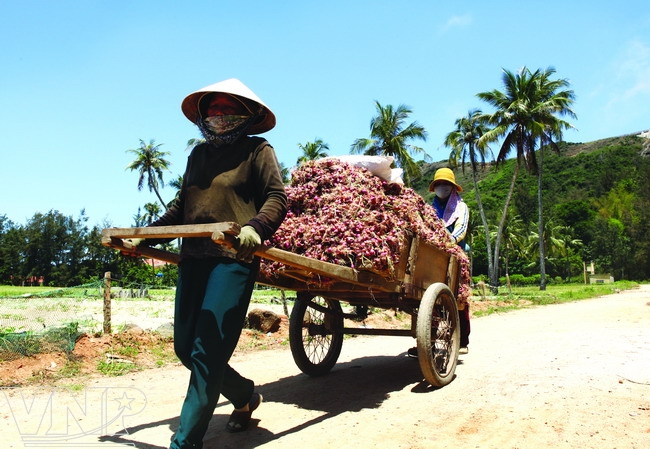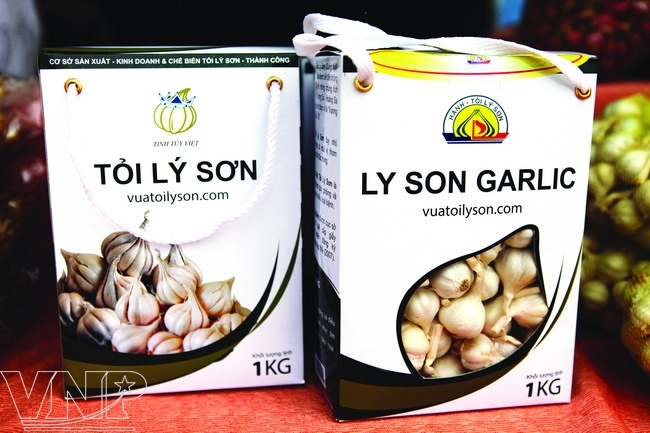The island district of Ly Son in Quang Ngai Province is known as not only the homeland of the Hoang Sa Flotilla, but also the kingdom of onions and garlic which have distinctive delicious tastes that other products of its kind can not compare with.
The island district of Ly Son in Quang Ngai Province is known as not only the homeland of the Hoang Sa Flotilla, but also the kingdom of onions and garlic which have distinctive delicious tastes that other products of its kind can not compare with.
In Vietnam, onions and garlic are planted mainly in the deltas of the rivers. Yet, these varieties of plants have stuck deep roots into the sand and grown well on Ly Son Island and become famous specialties.
About 400 years ago when the ancestors reclaimed Ly Son Island, they only saw Re – a variety of plant under the ginger family on the island. For this reason, the island is also called Cu Lao Re (Re Island). At that time, they brought onions and garlic to grow on the island to server their daily life that then became the second variety of plant to grow on the island.
|
|
Vo Hien Dat in An Vinh said: “Before 1975, onions and garlic were only planted in the garden of each family on a small-scale. However, after the national reunion the onion and garlic products on Ly Son Island were brought to the mainland and quickly became the most favourites of people in the land of Quang thanks to their strange and tasty flavour, more delicious than the others grown on the mainland. Realizing the value of these varieties of onions and garlic, the residents on the island started expanding the cultivation area and Ly Son Island now becomes the kingdom of these products.”
Learning about the cultivation of onions and garlic, we know that there are a few plants like onions and garlic that are extremely difficult to be cultivated on the island. It was the reason why Nguyen Van Minh in An Hai Commune told us that growing onions and garlic on this island is so hard and painstaking.
Ly Son Island was formed in the prehistoric age from the eruption of five extinct volcanoes so the island with an area of 1000ha is covered by cold lava, sand and coral. For this reason, to have sand for cultivating onions and garlic, the locals must use a machine to take sand under the coral reefs on the seashore and pour onto the fields at the foot of the two mountains, Thoi Loi and Gieng Tien. Then, they flatten the sand into different layers and scarify the sand using their hands before growing onions and garlic. These plants are grown in September or October and harvested the next March.
Onions and garlic are planted in September or October and harvested in March of next year. Ly Son onions are very tasty and eyes-catching.  Transporting onions from the fields to their houses. Each crop, Ly Son provides the market with over 5,000 tonnes of dried onions and garlic. Ly Son garlic is considered the "King" of its kinds.  Ly Son onions and garlic have become a famous brand name both at home and abroad. |
To make these plants root into the sand and grow well, the locals must work with the sweat of their brow. Minh added that during the period of planting to harvest, apart from fertilizing, they must water the plants twice a day in the early morning and in the afternoon to neutralize the salinity of sea water. If they forget to water the plants in the morning or in the afternoon, the plants will immediately die and it means the farmers build castles in the air. It took them nearly half of a year to carefully tend and water the plants before harvesting and these plants repay the locals’ hard working days.
Taking us to visit the fields of garlic at the foot of Thoi Loi that spreads to the seashore, Tran Ngoc Nguyen, Chairman of Ly Son District People’s Committee, said: “The island has now more than 300ha for cultivating onions and garlic, accounting for 1/3 of the total area of the island. Each crop, Ly Son provides the domestic and foreign market over 5,000 tonnes of dried onions and garlic, bringing about great economic benefits to the locals.”
Particularly, the garlic on Ly Son Island is considered the “king” of garlic and called a beautiful name “Toi ngoc” (pearl garlic) because the garlic pieces are as white as the colour of a pearl.
In 2009, the National Office of Intellectual Property, under the Ministry of Science and Technology, recognized the trademark for the garlic and onion products of Ly Son that creates the premise for these agricultural products to expand in the domestic market and further penetrate into foreign markets.
Onion and garlic cultivation and fishing are two major trades that help the locals on Ly Son Island to earn their living and develop the economy, making a contribution to protecting the national island sovereignty.
(Source:VNP)






